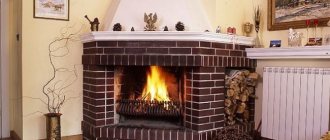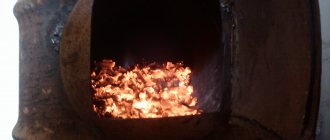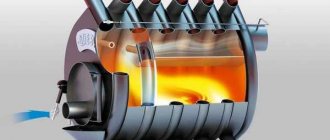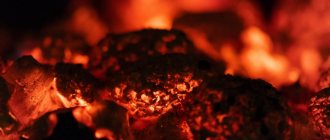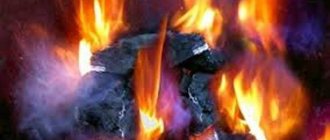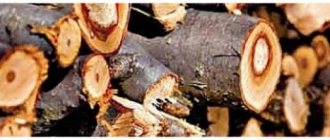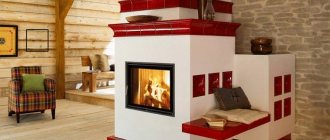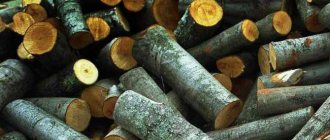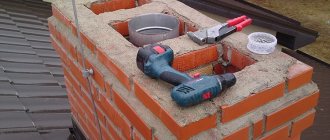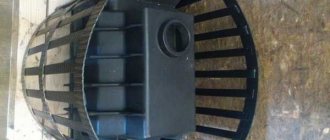Briquette composition
The materials for making Euro-firewood are usually various wood species, straw, cereal or seed husks, peat and coal. Let's look at them in more detail.
- Tree. The base function in such products is performed by compressed sawdust, shavings, bark and other non-format materials. First they are heated, and then they take shape using a press. And when heated, wood pulp releases a special substance - lignin, which, due to its qualitative characteristics, resembles glue. Thanks to lignin, briquettes retain their shape throughout the entire period of production and operation. An alternative to firewood in the form of fuel briquettes has a high calorific value - approximately 4300-5000 kcal/kg.
- Straw. Euro firewood from straw is made in a similar way. Their calorific value is slightly lower than that of previous briquettes - 4740 kcal/kg.
- Seed husk. Fuel from seed processing residues has the highest calorific value - 5151 kcal/kg. This is due to the presence of oil components in their composition. But you should be careful when using this fuel constantly. Although it burns well, it pollutes the chimney very much, which can soon lead to its clogging and malfunction of the entire structure.
- Cereal husk. This type of fuel is produced from rice husks. It has a relatively low heat transfer: approximately 3458 kcal/kg.
- Peat. The peat mass is pre-dried and only then pressed. During this, the material is compacted, which makes it possible to produce small products that are convenient to use and transport. Fuel briquettes for peat stoves emit 5000 kcal/kg during combustion. This is significantly more than the figure for conventional firewood - 3910. Therefore, they are much more economical. The best briquettes for a long-burning stove are made from this material. Ash from environmentally friendly fuels is often used as fertilizer in household plots and gardening.
- Coal. This fuel is made from coal dust. To do this, waste from the coal industry is crushed, sifted, and then also pressed. Coal briquettes for heating stoves do not produce much smoke. The same cannot be said about hard coal fuel.
Types of wood briquettes
The production of this type of wood fuel consists in the fact that wood waste (sawdust, bark, wood chips) is crushed into fine crumbs and pressed in special forms. Briquettes can be in the form of cylinders or rectangular bars weighing 500 grams to 2 kilograms. On sale you can find RUF briquettes, cylinders and PINI KAY briquettes.
RUF briquettes
Products are made in the form of small bricks. The sawdust is compressed with special German presses of the RUF brand (hence the name of the fuel), creating a pressure of 300 - 400 bar. Bricks are made with dimensions of 150×90×60 mm. RUF products are in great demand on the fuel market. The concentrate is supplied packed in film on pallets. 1 pallet = 1 ton = 1 m3.
Cylindrical briquettes
Products are made in the form of small cylinders with or without a radial hole. These products are manufactured on hydraulic and shock-mechanical presses, creating a pressure of 400-600 bar. The production of cylindrical briquettes does not require complex equipment or special conditions. These circumstances contribute to the creation of low fuel costs.
It should be noted that products can easily absorb moisture, which is why the products require moisture-resistant packaging during storage and transportation. The product is very fragile. During long-term transportation, poorly secured briquettes can collapse and turn into powder.
Briquettes PINI KAY
The bars have the shape of four and hexagonal elongated prisms with radial holes. Products are produced by compressing raw materials with powerful screw presses under a pressure of 1000 bar, followed by a firing process. The bars have a characteristic dark brown color.
The products are quite durable and resistant to storage in conditions of high humidity. PINI KAY products are characterized by high calorie content during long burning. Fuel production requires highly skilled labor and the operation of expensive equipment. This creates a high cost, which affects the final high price of the product.
Wood briquettes are widely used in smokehouses in the fish and meat industries. The fuel is used for fireplaces and home boilers and stoves.
Kinds
The method of processing raw materials plays an important role. Taking into account the manufacturing process, briquettes can be divided:
- Piny-kay. Fuel having the highest density of 1.40 g/cm3. The shape is similar to a cube or hexagon, which has a hole in the middle. The air inside the cavity ensures even combustion.
- Low density products - 0.8 g/cm3. These are squares or rectangles made from the smallest particles of material. They are characterized by high thermal conductivity and long-lasting combustion. Convenient to store and transport, do not take up much space.
- Products made from large sawdust with medium density. Their disadvantages include rapid combustion, frequent loss of shape and deformation. Due to low production costs, they have a relatively low price.
Heating with regular wood
Firewood has been used for heating for a very long time; it is a high-quality fuel for the home and bathhouse, barbecue and barbecue. The environmental friendliness of firewood will always be 100%, and this fuel has plenty of other advantages. Let us note the main advantages of firewood, without delving deeply into this topic:
- First of all, I would like to say that the process of harvesting, drying and storing firewood is understandable to everyone. From an early age we know how to look for firewood, collect and light it.
- Lighting wood is not difficult, even when it is damp. Some tree varieties can burn in high humidity, giving off heat.
- The cost of firewood is low, even if you do not go through the entire harvesting cycle, but buy ready-made logs or logs. (However, until the prices of different types of fuel are compared, it will not be possible to say which is more profitable.)
- Firewood is not afraid of mechanical damage and can be stored in a woodpile in completely different ways.
- From an aesthetic point of view, the wood burns perfectly. They create a beautiful fire and soulful crackle, and when some varieties burn, a characteristic pleasant aroma appears. For open fireplaces, where the appearance of what is happening is important, this fuel is considered optimal.
- The substances released during the combustion of wood have a beneficial effect on humans, they calm the nervous system and heal the respiratory system.
Strategic forest reserve for winter
We will also highlight the disadvantages of natural fuel:
- To obtain high heat transfer, the firewood should be well dried under natural conditions, which requires an extremely long time, for example, 1 or 2 years. The best firewood is wood that has lain in a dry shed for a couple of years.
- During long-term storage, wood loses some of its qualities, especially fragrant varieties of trees.
- Firewood takes up a lot of space; for its normal storage in the required quantity, it is necessary to build an appropriate structure.
- When using firewood, a lot of debris always appears (chips, bark, wood dust, sawdust).
Good to know: How to split wood manually and mechanically
Having become acquainted with the main capabilities of the two types of fuel, let's make a comparison.
Advantages and disadvantages
Heating with alternative fuels has its positive and negative sides.
Pros:
- High calorific value and heat transfer. These indicators are significantly higher for alternative fuels than for conventional logs.
- Long burning time. Therefore, their consumption is significantly less than that of firewood or coal.
- Uniform combustion. Briquettes burn without unnecessary noise and smoke. And they produce less ash than coal or firewood. This makes it easier to clean the oven device after use.
- Slight release of tarry substances. Thanks to this, the chimney does not become clogged.
- Long shelf life. Briquettes can be stored from 1 to 5 years (depending on manufacture).
- Environmentally friendly. The product is natural, without various impurities. Safe for people and the environment.
Minuses:
- Briquette fuel prices are higher. Firewood is much cheaper. But thanks to economical consumption, the costs are worth it.
- Purchasing such goods in some cities or towns is difficult.
- Products should be stored in accordance with the instructions. Therefore, you should prepare a clean and dry place.
- The ash gives off a pungent odor.
Comparison of “Eurowood” with conventional solid fuel
The cost of coal, firewood or pressed sawdust used for heating varies depending on the region. Therefore, there is no clear decision on the choice of one type of fuel or another. It is necessary to take into account the current price and conduct an analysis of comparative characteristics.
Specific calorific value of fuel
One of the main indicators of fuel efficiency is its specific calorific value (specific heat of combustion). This parameter determines how much mass fraction of a substance, when burned, will be required to release a certain amount of energy.
Comparative calorific value of various types of fuel. The values given are approximate and depend on many factors. But in general, the table shows the rating of solid fuels by specific calorific value
There is one nuance here: calorific value depends on mass, and firewood and sawdust briquettes are usually measured in cubes. When advertising compressed fuel, they often indicate that the energy output is almost twice as high as when burning wood, but they do not indicate the fact that the weight of dry briquettes per cubic meter is greater.
Let’s assume that the calorific value of freshly cut birch is about 2 kcal/kg, and that of briquettes is 4 kcal/kg. The weight of a folded cube of firewood is about 570 kg/m3, and the weight of the same volume of pressed material is about 800 kg. Therefore, a cubic meter of raw chopped wood when burned will give about 1.14 mCal, and briquettes - about 3.2 mCal, that is, almost three times more.
The thermal efficiency of industrially produced briquettes can be compared with charcoal or coal, but the latter is much cheaper.
Storage and ease of use
One of the disadvantages of pressed raw materials is its high hygroscopicity. The intense ability to absorb moisture leads to a loss of rigidity between the bound particles and possible crumbling of the briquette. Therefore, unlike coal or firewood, sawdust must be stored in a dry place.
However, in winter, pressed fuel can be kept under an ordinary canopy, since at sub-zero temperatures the absolute air humidity is low. You just need to ensure there is no direct contact with snow.
Fuel briquettes can also be kept indoors. Industrially produced pressed raw materials practically do not produce waste, unlike the same firewood.
Due to the dirt and dust created, coal and firewood are stored outside. Neat briquettes made from shavings can be kept in the veranda of your home
Pressed wood requires a minimal amount of ignition material to start burning. Here sawdust, like peat, has no competition.
Application in long-burning boilers
Nowadays, long-burning boilers are deservedly popular, especially among cottage owners. They are economical, have high efficiency and are easy to operate. Their only significant disadvantage is the cost of the equipment and the costs of its installation.
Many advanced boiler models are equipped with an automated fuel loading system. For its operation, it is necessary to use a combustible material of uniform shape. For this purpose, pellets are made from sawdust and shavings.
Pellets are made from wood waste by pressing. They have the form of granules with a diameter of 6-9 mm and a length from 10 to 70 mm
The use of this type of fuel in such boilers allows maintaining the required temperature without human intervention. This allows cottage owners to be away for a long period (up to several days) without the risk of the home cooling to unacceptable levels.
Briquettes or firewood?
Although Euro firewood is usually made from wood waste, it has completely different characteristics. Euro firewood is aesthetically pleasing and easy to store and use. They burn slowly and provide more heat. But the amount of heat from briquettes is much less than from firewood.
Therefore, it will take a little longer to heat a house in severe frosts than with wood heating. And this causes some inconvenience. The ash content of alternative fuels is low.
But their ashes have a pungent odor, which may not please others. Briquettes do not create aesthetic pleasure, because they burn without noise or crackling. Using firewood is much more pleasant: you can create a cozy atmosphere.
Is it better to heat the stove with wood or briquettes? There is no clear answer to this question . The optimal heating scheme for a house: burning both types of fuel (classical and alternative) simultaneously.
It is better to achieve the optimal temperature using ordinary firewood, and then only maintain it with briquettes. The use of briquettes alone should be used for long-burning stoves. This way you will save yourself from the need to constantly add a new batch of firewood.
What briquettes are best to use?
Different types of briquettes have different calorific values. This feature should be taken into account when choosing a product, because it is the most important. Sawdust briquettes are considered the best option.
These fuel briquettes are best for a stove in a house, bathhouse, cottage or other room. They have high heat transfer, burn for a long time, leave little ash, are easy to use and transport, and do not pollute the air.
Briquettes of sunflower seeds and coniferous husks also have good performance, but due to the presence of oils they pollute the chimney. As a result, the heating device will require frequent cleaning.
Before purchasing, pay attention to the structure and moisture content of the product. If it becomes deformed or crumbles when pressed, it is better to refuse such a purchase. And high humidity reduces the thermal efficiency of the product. Give preference to Pini-kay fuel. It has maximum density, burns more evenly and longer.
How much are?
The price of briquettes for heating a furnace depends on the technology and material from which the product is made.
- Alternative fuel of the Pini-kay type made from pine needles will cost an average of 8,900 rubles. for one ton, from birch - from 9,500 rubles.
- RUF briquettes are cheaper: sawdust 6500, pine needles 6000, pine and birch 6500, birch 6900 rubles.
- Nestro briquettes are the most inexpensive: 7500 per ton. Peat briquettes will cost the stove owner 8,000 rubles, and coal briquettes – 9,500 rubles.
You can purchase briquettes in specialized stores, as well as on websites on the Internet. Online shopping will be a little more profitable, since you will not have to pay for the services of consultants and renting store premises. But in the store you can personally see the quality of such a purchase, which is very difficult to do via the Internet.
